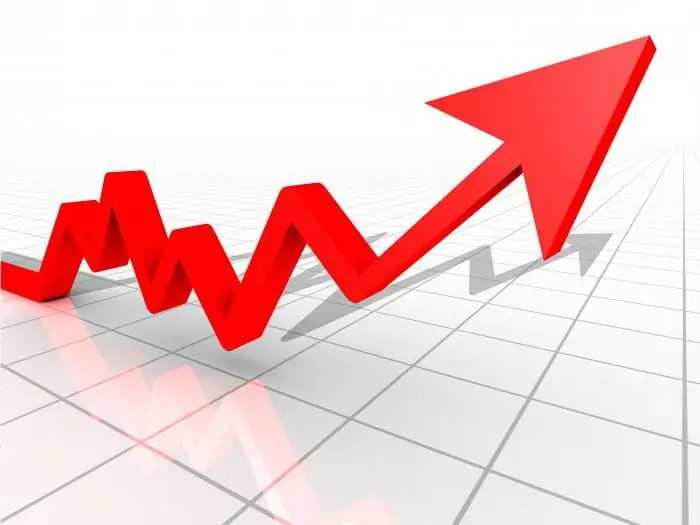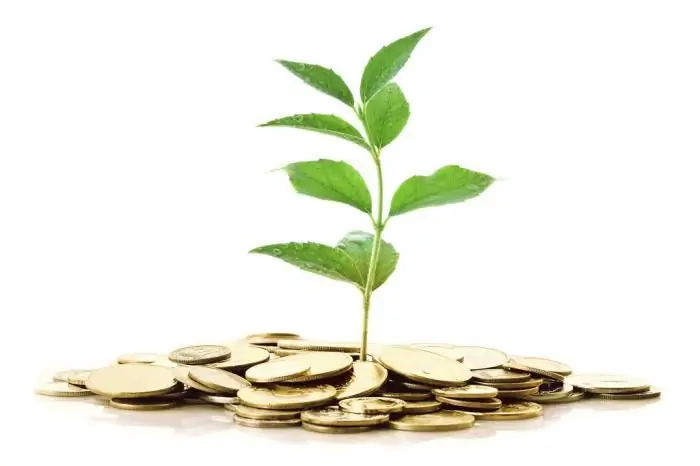2025 Author: Howard Calhoun | [email protected]. Last modified: 2025-06-01 07:12:56
It is impossible to talk about finance, entrepreneurship, business and not mention some essential terms. For example, in order to build correct economic formulas, it is necessary to understand what functions of investment exist, how they work, and what role they play for the development of the entire industry.
Essence, types and examples
In the well-known theory of Keynesianism, investments and, above all, investment expenditures are an integral part of the total expenditures of the population, along with government purchases and net exports of goods and services. Economists consider it the most volatile and dynamic component due to its dependence on many factors. If we take a deeper look at investments (functions, types, their meaning, methods of application), then we will have to go a little beyond this theory.

What is meant by investment in a broad sense?
Scientific works of classical, Keynesian, marginalist Marxist and other schools are devoted to the study of the concept of investment. Let's take a closer look at threedefinitions.
Investment (in the broadest sense) is the investment of capital in the economy, the scientific and technical sector, infrastructure, social and environmental activities, in the development of production and entrepreneurship.
Investment in the narrow sense
From the point of view of finance, the functions of investments are reduced to the investment of funds (assets) that are used in the process of production and economic activities. Economy interprets investments as expenses of subjects for the purpose of capital accumulation, providing for the creation of new capital and compensation worn out funds. From this side, the main function of investment is to generate income. In other words, the subjects of the national economy invest part of their income in the development of the economy so that it pays off and returns to them in an increased amount.
Entrepreneurs also consider investment as a business transaction for the acquisition of productive and non-productive assets and financial instruments in exchange for property or cash. At the same time, investment spending can help increase capital or maintain it at the same sufficient level.
And although the share of investment spending in total national spending is one-fifth, fluctuations in business activity and positive economic growth depend on them - other things being equal, an increase in investment proportionally increases the gross domestic product.

Functions of investment in the economy
From the definitions of investment it can be seen thatthat these processes can be carried out both at the state and at the private level of an economic entity, but in the end it all comes down to improving the welfare of the state. This means that the functions that investments perform are designed to satisfy all interested parties: households, banks, enterprises, formal and informal institutions, associations, and the public sector. Here are four key properties that make investment the cornerstone of macroeconomics:
- The distribution function is interpreted as follows: choosing where to invest money or assets, an entrepreneur or the state contributes to the development of one industry more than another. On an example, it looks like this: domestic ones cannot compete with foreign electronics and cars, it is more profitable for an entrepreneur to invest in something else.
- Regulatory property: investments are made globally and affect related sectors of the economy. The new plant involves laying roads, a recreation center, creating new jobs, etc.
- Incentive: Investing involves putting money into improvement. Science, technology, the level of education are being optimized, and as a result, the quality of life and the welfare of the country are improving.
- Indicative: property of investment closely related to the processes of capital accumulation and maintaining the balance of an open economic system.

Having considered the theoretical aspects of the formation and functioning of investments, let's move on to their graphical display,which clearly shows how the consumption function, the investment function, savings and consumption are interconnected within the economic system of the state.
Definition
Any function, mathematical or economic, is the dependence of the final result on one or many factors. Investment functions are also models in which the endogenous variable (the end result) is investment spending, and the exogenous variable is determined by the objectives of the study.
If there is only one independent variable, then the others are said to be "under other given conditions". So, if investments are given as a function of income, this means that the bank interest rate and prices have not changed significantly in this period.
The more independent variables, the higher the reliability of the model and its proximity to the real conditions of the economy. The dynamics of changes in variables can vary greatly in different periods, and to simplify the task, researchers choose one or two main factors on which the investment functions will depend.

Relationship between investment and interest rate
Without exaggeration, we can say that the amount of investment depends on the interest rate, while the change in other factors is taken over by the autonomous investment function included in the multifactor model, which has the following form:
I=Ia - dr (1), where
I is total investment spending;
Ia is autonomous investment spending;
d is investment sensitivity to decrease orrate increase, %;r - real interest rate.
The meaning of the interest rate is explained quite simply. Each businessman, before investing money in a risky enterprise (and 100% risk-free investments do not exist in principle), estimates how much he can earn on it and how much he needs to spend for this. For large-scale investments, domestic financial resources are often not enough, and the entrepreneur is sent to a bank or non-banking financial institution, which demands a price for its services - the same percentage. The higher the price of the bank, the lower the businessman's profit and the ratio of profit to costs. As you know, maximizing profits from all activities is the ultimate goal of any enterprise.

More examples
You need to understand that there are a huge number of ways to use such an instrument as investment. The income function, for example, is built taking into account this financial transaction. In addition to loans and non-bank loans for the purchase of equipment, machinery or financial instruments, an entrepreneur can spend money from his own pocket. At the enterprise, this is the part of the profit that remains after the payment of taxes and other planned deductions. In this case, fluctuations in the final amount of investment costs will directly depend on the change in the operating income function of the enterprise. Income grows and its consumed part - investments increase. Growing losses - investment is reduced or curtailed for an indefinite period. Then the investment function isview, which is significantly different from the previous example, since we are adding total income.

Marginal propensity to invest is a multiplier that shows how much investment increases or decreases when a unit of income changes. The higher the multiplier value, the more the entrepreneur is risk averse. If you win, investments can return in multiples, and if you lose, they can lead to huge losses and even bankruptcy.
Consumption and investment
All incomes of economic entities are distributed into two funds: consumed and accumulated. The accumulated part, in other words, savings, is the profit that remains inside the firm and is inactive for some time. The consumed is used to pay taxes, liabilities, salaries to employees and other purposes.
Investing and risk
Investments are consumed and returned to enterprises in the form of equipment and assets, which means that it is important for the entrepreneur that the capitalized part of the profit is as small as possible. On the other hand, if the investment in the period under review was not very successful and did not provide an inflow of money, the company is forced to resort to external sources of financing. Again, these are banks, financial institutions, formal and informal financial markets. And again the question arises: to risk or not to risk?

Optimal income (profit) distribution structure
Probably one ofquestions to which neither practitioners nor theorists can give an unambiguous answer: where is the equilibrium point for investment and accumulation? Even within the framework of one enterprise, it is impossible to say unequivocally what is better, to accumulate or to consume, because market conditions, technologies, socio-legal and political sectors are constantly changing. What tomorrow will bring huge losses, yesterday threatened with bankruptcy, and vice versa.
Mathematically, investment functions do not provide a universal solution - they only display average trends, discarding a number of minor factors that can suddenly become significant. For the manager, they serve as a generalized example, and the final investment decision is made after a thorough study of all factors and the real state of affairs in the economy.
Recommended:
Sectors of the economy: types, classification, management and economics. The main branches of the national economy

Each country has its own economy. It is thanks to industry that the budget is replenished, the necessary goods, products, and raw materials are produced. The degree of development of the state largely depends on the efficiency of the national economy. The higher it is developed, the greater the economic potential of the country and, accordingly, the standard of living of its citizens
Evaluation of investment projects. Risk assessment of an investment project. Criteria for evaluating investment projects

An investor, before deciding to invest in business development, as a rule, first studies the project for prospects. Based on what criteria?
Investment: investment multiplier. Investment multiplier effect

The investment multiplier is a coefficient that shows the change in gross product along with investment. Its effect can be seen by considering a specific example
Investment banks - what is it? Types and functions of investment banks

What are investment banks? What are the features of their activities?
Appropriating economy - what is it? Appropriating economy: definition

Many historical facts testify to the origin of man from animals. Even 2 million years ago, he began to stand out among his own kind by upright walking, improving his hands and brain. Constant changes also took place in the field of food production. One of the ways to ensure existence was the appropriating economy. What it is and what it led to is described in this article

